There are several categories of dog bathing products and many products within each category. It is important to select products appropriate for the dog you are bathing.
Shampoo
Shampoo is a cleaning product that helps to remove dirt and debris from a dog’s skin and coat. Shampoos also remove oils, dander (dead skin cells) and that ‘doggy smell’. You must use dedicated dog shampoos because the pH of dog skin differs from that of humans. Using human shampoo on dogs can cause irritation and even dermatitis (skin inflammation).
It is important to choose the right shampoo to match [the dog’s] skin and coat needs.Williams (n.d.a)
Choosing the right shampoo for the dog
Many different types of shampoo may be suitable for any particular dog. To help you decide which one to use, consider what you are trying to achieve by bathing the dog. Then use a process of elimination. Asking yourself questions about the dog’s needs can help you determine which types of shampoo may be appropriate for it. Start with the most significant requirements, then work your way down to personal preference.
- Does the dog have issues that require medical treatment? If so, which medicated shampoo is required?
- Does the dog have any known allergies? If so, choose a hypoallergenic shampoo that also meets any other bathing requirements.
- Does the dog have dry skin? If so, select a nourishing shampoo that will relieve dryness and itchiness.
- Is the dog particularly dirty? Is it particularly smelly? Has the client requested a colour-enhancing wash, or that you use a particular type of shampoo?
Once you have a good understanding of the dog’s needs, the work instructions and the client's requests, consider the type of coat and choose a shampoo that meets all the requirements.
The following list identified several of the more common types of dog shampoo.
- General-purpose shampoo
- Medicated shampoo
- Flea and tick shampoo
- Hypoallergenic shampoo
- Dry or itchy skin shampoo
- Whitening or colour-enhancing shampoo
- Clarifying shampoo
- Deodorising shampoo
- Tearless shampoo
- Deshedding shampoo
Watch
The following video, Dog shampoo - how to choose the right one for your dog | S6 Ep57 | Pooches at Play (2:08 min) provides a brief overview of some different types of shampoo and their purposes.
General-purpose shampoo
General-purpose dog shampoo is suitable for most dog coat types.
Medicated shampoo
Medicated shampoos contain active medications to treat veterinarian-diagnosed skin conditions, such as psoriasis or a fungal infection. Different skin conditions will require different medicated shampoos. While most medicated shampoos do not need a prescription, you should still seek veterinary advice before using one on a particular dog.
Flea and tick shampoo
Flea and tick shampoos contain ingredients that actively kill infestations by external parasites, such as fleas and ticks. In some areas where external parasites are common, it may be recommended to use flea and tick shampoos as a preventative, even if the dog does not currently have an infestation.
Not all products will kill all types of parasites. So, make sure to read the label and manufacturer instructions carefully.
Hypoallergenic shampoo
A hypoallergenic shampoo is required for dogs with highly sensitive skin or allergies. Hypoallergenic shampoos tend to be fragrance-free and contain fewer processed ingredients.
Dry or itchy skin shampoo
Dogs can get dandruff too! Excessive dander may be the result of dry or itchy skin. So, using a shampoo that helps to exfoliate and moisturise the skin can help improve the health of both the dog’s skin and coat. Dry skin shampoos will often contain ingredients such as “silk, wheat and oat proteins, safflower oil and wheat germ oil” (Williams n.d.), which are natural emollients (moisturisers). Some may also contain aloe, peppermint or eucalyptus oils to reduce itchiness.
Whitening or colour-enhancing shampoo
Several types of shampoo and post-bathing products are formulated to enhance the colour of a dog’s coat. Whiteners make white coats look brighter, while many colour enhancers contain temporary dyes to strengthen the colour of the coat. When using a colour-enhancing shampoo, make sure to select a product that is suitable for the dog’s coat colour.
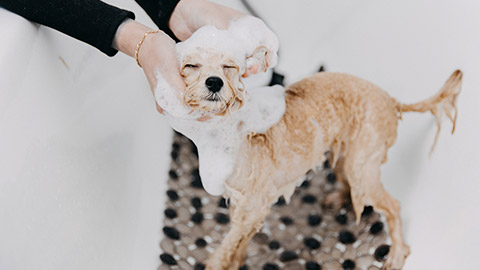
Clarifying shampoo
Clarifying shampoos are strong surfactants (chemicals that help different substances mix, such as water and oil) and are used to strip dirt and oils from very dirty dogs. Many groomers will use a clarifying shampoo first, then apply a second shampoo that is best suited to the dog’s coat.
Deodorising shampoo
Dogs with particularly oily skin and hair tend to have the characteristic ‘doggy’ smell, which can be difficult to eliminate. Deodorising shampoos tend to contain ingredients, such as citrus, baking soda or even antibacterials, that kill the bacteria that build up on oily skin and hair and cause the unpleasant smell. Perfumed products without these active ingredients will only mask the smell, rather than remove it (Williams n.d.).
Tearless shampoo
Dog shampoo, just like human shampoo, can really sting if it accidentally gets into the eye of the dog. Tearless shampoo is particularly gentle. However, you should always do your best to avoid getting any product into a dog’s eye regardless of whether it is tearless or not.
Deshedding shampoo
Deshedding shampoo helps to release dead hairs from their follicles and fall out of the coat more easily. Deshedding shampoo may be particularly useful for double-coated breeds or dogs that are prone to heavy or prolonged shedding.
Other grooming products
Once the shampoo has removed the dirt, oil and grime from the dog’s coat and skin, you should use a suitable conditioner. Conditioners moisturise the skin and hair, making the coat shiny, and help to reduce tangles to make it easier to brush the dog. They also help to seal broken hair follicles, keeping the coat healthy.
As with shampoos, there are many different conditioners formulated for different purposes. Some conditioners (called ‘leave-in’ conditioners) should not be rinsed out of the coat. Make sure you read the label and the manufacturer’s instructions to help you select the most appropriate conditioner for the individual dog and apply it appropriately.
Eye wipes and ear cleaners are products that are specifically designed to help clean these delicate areas of dogs. Eye wipes are small pads that contain gentle cleansers to help remove dirt, eye discharge and tear staining. Ear cleaners are liquid cleansers that are typically bought in small dropper bottles. They help to dissolve ear wax and to remove build-up of any discharge in and around the ears.
Some whiteners and colour enhancers are post-bathing products and should be used after the dog has been washed. Other common post-bathing products include products that you spray into the coat and do not rinse out. These include detanglers to help with brushing and volumisers to help with styling.
Follow the work instructions and client requests as to whether post-bathing products are required.
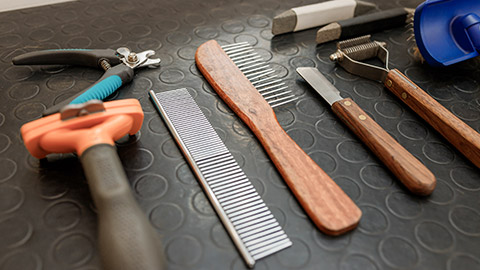
As with selecting products, you must consider the work instructions and the needs of the individual dog when selecting equipment to bath, dry and brush a dog.
Bathing Equipment
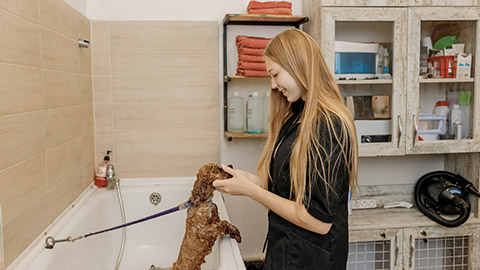
Bathing equipment includes all the items you use to wet and wash a dog. There are several different types of baths commonly used in grooming facilities. Each has its benefits and disadvantages for washing dogs. The four types we will look at here are:
- Hydrobaths
- Hydrosurge
- Spas
- Grooming baths
Hydrobaths
There are many different types of hydrobath. They can have one (single) or two (dual) tanks, some have an integrated heater while others don’t, some have a hose attachment and a float system so they can automatically fill, while others must be manually filled using a tap. However, all types of hydrobath combine a bathtub with a pressurised water pump. You add the shampoo to the tank and the pump sprays water and shampoo through a shower head at a pressure suitable to reach the skin of even heavy-coated dogs. The used water is collected in a reservoir, then cycled through a filter and reused to reduce the amount of water and products required to wash the dog thoroughly (The Pooch Mobile n.d.).
The water pressure physically helps the shampoo to remove dirt, dander and accumulated wax from the skin and hair. When set to an appropriate pressure, the water also massages the skin, promoting circulation and evenly distributing the dog’s natural oils, which keep the skin and coat healthy and looking good.
Advantages and disadvantages of the hydrobathing system
The clear advantage of the hydrobathing system is the water pressure. It is high enough to fully penetrate even a thick undercoat, all the way down to the skin. This saves bathing staff time and reduces the strain on their hands and bodies because they don’t need to manually work the water and shampoo into the coat and down to the skin. Recycling the water also reduces the amount of water and product needed to thoroughly wash the dog, saving resources and money.
However, the high-pressure water can be too powerful for small dogs or puppies. Some hydrobaths have different shower heads that can be used to alter the pressure and should be changed to suit the individual dog’s needs. There is also an increased risk of causing or spreading skin conditions and infections if the system is not cleaned and disinfected properly between uses.
Watch
The following video, Savel Hydrobaths SUPREME Vs DELUXE Model (2:25 min), compares two hydrobath products from the same manufacturer and demonstrates the key features present in most hydrobaths.
When to use the hydrobathing system
The hydrobathing system is best to use when bathing double-coated breeds such as the Golden Retrievers or the different Spitz breeds. It is also most effective when bathing very dirty dogs that need a really good scrub!
Hydrosurge
A hydrosurge bathing system is a portable unit that connects to any hose or shower, so it can be used in many different types of bathtubs. The hydrosurge shower head contains a replaceable shampoo cartridge or is connected to product bottles via tubes. This allows the shower head to dispense the product along with the water. Some hydrosurge systems allow you to control the amount of shampoo that is added to the water. However, many systems also limit the types of shampoos you can use.
Hydrosurge systems oxygenate the water with small bubbles, and the oxygen, along with the water pressure, helps keep the skin of the dog clean and healthy.
Watch
Review the following video, Overview of the Hydrosurge BathPro™ 5.1 system (2:29 min), for the key features of this type of bathing system.
Advantages and disadvantages of the hydrosurge system
Advantages of the Hydrosurge bathing system include that it tends to be much cheaper than the integrated bathtub and water pump systems. However, controlling the amount of product used during bathing can be difficult, which can increase costs if excessive amounts are drawn through the shower head.
Spas
A spa is a bathtub containing jets that pump air bubbles into the water. A microbubble spa produces tiny bubbles that are only 20-40 µm (micrometres) in diameter. One micrometre is one millionth the length of one metre! Some microbubble spas are called ‘milk spas’ because the number of tiny bubbles in the water makes it look milky white.
Manufacturers claim that the bubbles’ tiny size means they are small enough to penetrate the skin and remove dirt and oils from the hair follicle. Oxygenating the skin and hair follicles has been shown to be a gentle but effective treatment for various skin conditions.
You add shampoo directly to the water of most types of spas, ensuring the water does not reach any higher than the dog’s withers. You must wash and rinse the dog’s head and neck by hand or using a shower head. If the spa has one attached, it is usually very similar to that of a hydrobath.
Advantages and disadvantages of spas
The clear advantage of a spa is that the multiple jets release lots of water at once, making the washing and rinsing processes very quick. With the jets positioned under the surface of the water, the groomer tends to stay drier, compared to all the splashing that happens when using other bathing systems.
However, spas, microbubble spas in particular, tend to be very expensive to purchase and run. They also require the dog to be at least partially submerged in the water. This can be risky with smaller animals because they could accidentally dip their heads under the water if they slip or trip in the spa. Many dogs are uncomfortable being even partially submerged, and spas could cause or increase anxiety in these dogs.
Grooming Baths
A grooming bath is the most basic type of bath. It has no integrated equipment, such as heaters or pumps, and is similar to a home bathtub. Grooming baths are used to handwash dogs, where you first wet the dog using a tap or hose, then scrub it with shampoo or other products and finally rinse all the products out of the coat.
Advantages and disadvantages of grooming baths
Grooming baths tend to be much cheaper bathing systems because they do not have integrated pumps or heaters. They are also simple to use and clean. However, without the help of high water pressures, handwashing is very laborious and can cause the bather joint and back injuries in the long term.
When to use grooming baths
Puppies, seniors and dogs with many handling requirements often benefit from a grooming bath's quieter and calmer environment. You also often have greater control over the dog’s movement when in a simple grooming bath than in some other bathing systems, making less-cooperative dogs easier to manage.
Other Bathing Equipment
Other bathing equipment includes items that help spread the shampoo, conditioner and other products into the coat, such as loofahs, exfoliating mitts, sponges and brushes.
Combs, such as flea combs are great to use while bathing to remove crusted debris, such as eye discharge. Simply allow the crusts to soak in the water, then gently work them out with the comb.
Non-slip mats are an important piece of bathing equipment because they help provide stability to dogs while they are in the potentially slippery bath.
Drying Equipment
There are three general methods of during a dog:
- Air drying – just let the dog shake and dry on their own without using any equipment
- Towel drying – using towels and chamoises to remove excess water from the coat
- Blow drying – using electrical equipment to increase the rate of drying.
Towels
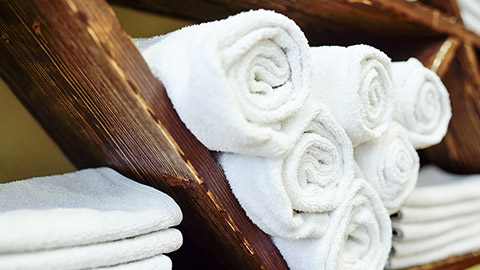
Towels are typically made from absorbent materials such as cotton or chamois (pronounced ‘shammy’). Traditional chamois towels were made from ultrafine leather, but many are now made from superabsorbent cotton.
Chamois towels can be wrung out and reused multiple times on the same dog. Traditional towels lose their effectiveness as they become wet, so you may need several towels to dry a large dog or one with a very heavy coat.
Depending on the type and size of towels available, and the dog you are bathing, select an appropriate number of towels for drying. After towel drying, depending on the type of coat, the dog will still be damp. You can towel-wrap the dog in a clean, dry towel and allow the towel to soak up a little more of the water. If the coat is short, letting the dog air dry after towel drying the excess water may be appropriate. Blow drying may be required to fully dry or style longer or thicker coats.
Blow Dryers
Blow dryers produce a directed stream of air that may or may not be heated. The increased airflow over the hair speeds up drying. Blow drying is particularly useful for drying the thick undercoats of double-coated dogs. If the hair does not fully dry, it may cause matting, fungal infections, hot spots (acute dermatitis – inflamed, hairless patches of skin that can ooze pus) or other skin conditions (Animal Behavior College n.d.b). A damp dog will also develop the characteristic ‘wet-dog smell’, which defeats the purpose of bathing the dog!
Many different blow dryers are suitable for pet grooming. However, that can be broadly categorised into three different groups:
- Cage dryers
- Fluff dryers
- High-velocity dryers
Cage dryer
A cage dryer is used to dry the dog while it is in a cage. They can be free-standing or attach directly to one or more cages. They tend to have low airflow and are often much quieter than other dryer types, which may be less scary for some dogs. However, the low airflow speeds and the ability of the dog to move out of the airflow mean it can take a long time to dry the dog.
It can also be difficult to monitor the airflow temperature, so it is recommended that cage dryers are run on a cool or very low heat setting to ensure the dog does not suffer from heat stress. You should also check on the dog every few minutes to ensure its safety and wellbeing (Mattox 2023).
Fluff dryer
A stand or fluff dryer is mounted on a stand or on the wall, which leaves both your hands free to brush and fluff the coat as you dry it. Some fluff dryers have attachments that allow you to direct airflow. They are great for finishing off drying the more delicate areas of the dog, such as the face, because they tend to have lower airflow. However, many have variable airflow and heat controls.
Fluff dryers are most commonly used on a low airflow but higher heat setting to brush and style the coat as it dries, particularly when fluffing a curly coat is required.
Watch
The uses of a fluff dryer are explained in the following section of the video, Different Types of Dryers for Dog Grooming | Dog Handling & Grooming Equipment Series (0:58 min).
Single motor high velocity dryer
High-velocity dryers are typically known simply as force or HV dryers. These dryers use powerful motors to create airflow with a high enough velocity (speed) to force the water out of the dog’s coat. When using an HV dryer, you can often see a cloud of tiny water droplets blown out of the coat. There are single- and dual-motor varieties. Dual-motor HV dryers tend to create a higher velocity than the single-motor versions. Some single- and dual-motor HV dryers variable have speed settings. Different HV dryers also require different amperage in the electrical circuit. Some require a dedicated circuit to power the appliance effectively.
The benefits of using an HV dryer include the following.
- The high-velocity airflow dried coats very quickly.
- While there is no heating element, the heat produced by the working motor increases the airflow temperature.
- Doubles as a de-shedding tool. The airflow blasts away loose hair, making the coat easier to brush later.
The following section of the video, Different Types of Dryers for Dog Grooming | Dog Handling & Grooming Equipment Series (2:08 min), provides an example of an HV dryer and discusses some common techniques for its use.
HV dryers can be very noisy, and some dogs may find the sound of the motor and the pressure of the airflow a little intimidating at first. It is recommended to avoid using force dryers on sensitive areas for the dog, such as the face and genital regions. Some dogs may benefit from a ‘happy hoodie’ when you use an HV dryer. A happy hoodie, such as the one shown in the following image, is a loop of soft, stretchy material that is placed around the dog’s head and pulled up to cover the ears. The hoodies help lower the dryer’s noise and reduce anxiety in some dogs.

Brushing Equipment
Brushing is important for dog coats to remove tangles and dead hair, which may be uncomfortable for the dog and can cause skin conditions if left unattended. Brushing massages the skin and helps distribute natural oils across the skin and hair, preventing dry skin and itchiness (Hartz n.d.). It also stimulates the blood vessels in the skin, improving circulation.
However, as with all grooming equipment, many different types of brushes and combs exist. In this module, we will focus on four main types of brush:
- Slicker brushes
- Rakes
- Bristle brushes
- Pin brushes.
| Brush type | Description | Uses | Tips for use |
|---|---|---|---|
Slicker brushes
 |
Slicker brushes have several rows of thin wires that are positioned very close together on the brush head. The wires have a slight bend and come in variable lengths. | They are most commonly used to remove loose hair and to detangle mats on medium to long-haired and wavy coats. With the range of different length wires, slickers are suitable for most breeds. |
|
Rakes
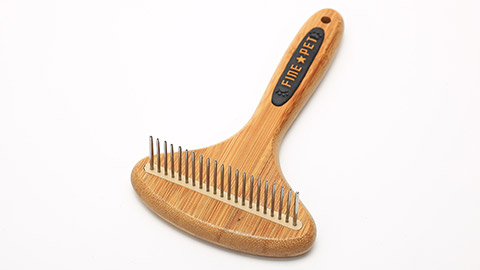 |
Rakes feature one or two rows of firm pins, positioned fairly close together. Some have a row of sharp teeth that help to cut through thick matts. | For removing tangles and loose hair in the undercoat. |
|
Bristle brushes
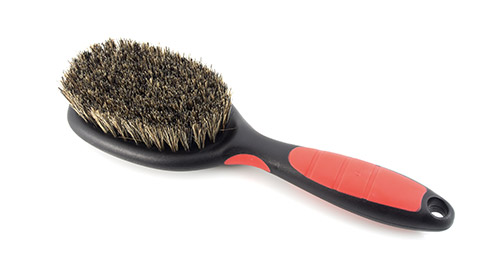 |
Bristle brushes have natural or synthetic bristles that are packed tightly into clusters in the brush head. | Remove loose hair from short or smooth-coated dogs and distribute skin oils. |
|
Pin brushes
 |
Pin brushes usually have an oval head with loosely arranged, flexible wires with pins (little balls) on top of each wire. | Will only remove very loose hair. Best used to finish off a brush-styled coat. Most suitable for finishing styling for show dog breeds, such as poodles or the Lhasa Apso. |
|
Other Brushing Equipment
Other brushing equipment include:
- Combs
- Flea combs
- Bushing products
- Grooming belly stands.
Combs
Regular combs, sometimes called greyhound combs or line combs, have firm, metal teeth that are regularly spaced. They are suitable to use on all medium to long coat types and are very useful for finding and getting rid of small knots.
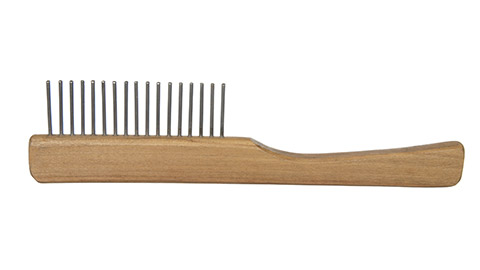
Flea combs
Flea combs, such as the one shown in the following image, are useful for manually removing fleas and their eggs from dog coats. The teeth are very firm and positioned very close together to catch the flea and their eggs as you pull them through the dog’s coat.
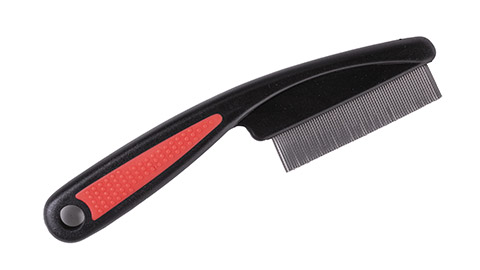
Bushing products
Brushing products, such as volumisers and detanglers, are also useful when brushing a dog. Volumising products help to give the coat a fuller look and feel. Detangling products coat hair follicles to help them slide over one another and make tangles easier to brush out.
Cushions and stands
A top knot cushion is a peanut-shaped cushion that can be used to support a dog’s chin while you style their top knot. They are available in several sizes and can accommodate different dogs, depending on the position you use them in.
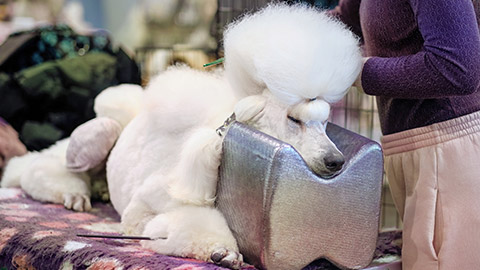
A grooming belly stand is a large, firm cushion that slides under the dog’s abdomen and prevents them from sitting down or moving around too much while you are brushing them. They may be useful when working with a wriggly dog or if the client has requested styling and you want to ensure it is even.
Grooming Tables
A grooming table is a surface on which you dry, brush and clip a dog. As with all grooming equipment, a wide variety of grooming tables are available to suit various purposes. Regardless of the type of grooming table you use, it should have a grooming arm attached to it. A grooming arm is an upside-down L-shaped or H-shaped bar that reaches over the grooming table and has a grooming loop attached to it. The grooming loop is critical for dog restraint and safety, and we will discuss them in the next section about safety equipment.
Regardless of the type of table you use, ensure that it is stable and strong enough to support the dog’s weight. Dogs will feel very vulnerable on wobbly tables, and it is dangerous for both the dog and the groomer if the table tips over or breaks.
Types of Grooming Tables
There are four broad categories of grooming tables:
- Basic tables
- Hydraulic tables
- Electric tables
- Rotating tables
Basic tables
Basic grooming tables have set heights that cannot be adjusted while a dog is on the table. They are the simplest type of grooming table and are often the cheapest. Some basic tables can be folded away for easy storage or transport. This might be particularly useful for mobile groomers who travel to dog shows, clients’ homes, or who have limited vehicle space.
Folding tables are often less robust than non-folding tables, so check the weight capacity (the maximum weight of a dog that can safely stand on the table) and stick to it!
Hydraulic tables
Hydraulic grooming tables use pressurised gas cylinders (like those used in adjustable office chairs) to help you lower and raise the height of the grooming table. Some hydraulic tables can be lowered to a height where a medium-to-large dog can walk onto the table without you needing to lift the dog. This reduces the strain on your back and the risk of manual handling injuries.
The height of most hydraulic tables is adjusted by manually pushing a foot lever. It can be very time-consuming and take a lot of effort to lift the table from its lowest (approximately 46 cm) to highest (approximately 122 cm) setting with a medium-to-large dog on it. For this reason, many groomers recommend only using hydraulic tables when working with small-to-medium dogs (Perreault 2018). The pumping action of raising the table can also be quite jerky, and many dogs can find this unsettling (PetEdge n.d.).
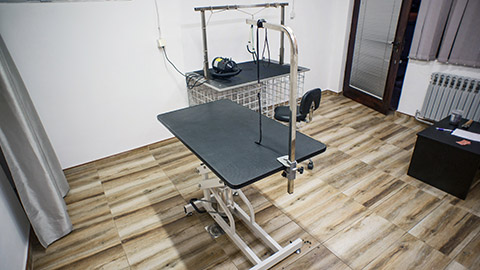
Electric tables
Electric grooming tables are also height adjustable. They use an electric motor to raise and lower the table, which is much smoother than a hydraulic table, and can usually be lowered further than the hydraulic equivalent – approximately 15 cm. While electric tables can be considerably more expensive to buy and run than hydraulic tables, they are more suitable for larger breeds of dogs.
Both hydraulic and electric tables reduce the physical strain on the groomer because they reduce the need to pick up larger dogs and can be adjusted to a height at which the groomer is most comfortable working.
Rotating tables
A rotating grooming table is one that allows the groomer to easily turn the dog rather than having to move around the table. Many rotating tables are raised tabletops that can be placed on top of existing tables or benches. While they are available in several sizes, rotating tables are typically used when working with Toy and other small breeds.
Some hydraulic and electric tables are available with rotating options.
Watch
The following video, Grooming Tables | Dog Handling & Grooming Equipment Series (9:27 min), goes into great detail about the different types of grooming tables available with a particular focus on portable grooming tables.
Other Grooming Table considerations
Grooming tables come in several different sizes. The table is safe to use as long as the dog has some space between it and every edge of the table, regardless of its position. Drying and brushing a small dog on a large table is also fine, as long as the grooming loop can be adjusted for the dog’s comfort.
The surface of the table is also important for both the safety of the dog and its welfare. Non-slip surfaces help the dog feel more secure because they reduce the risk of falling over on the table or slipping off it. If the surface is slippery, add a non-slip mat on top of the table. Pyramid matting is a common choice because it provides an excellent non-slip texture and is easy to clean. A padded, non-slip matt can also make the drying and brushing experience more comfortable for dogs, especially for very long services, such as styling the coat of a Poodle for showing.
Safety Equipment
There are two main categories of safety equipment when working with animals. Personal protective equipment (PPE) are the items you wear to protect yourself from hazards, and animal restraint equipment are the items that minimise harm to both you and the animal you are working with.
Personal protective equipment
You will work with unpredictable animals, large equipment, chemicals, and slippery surfaces when bathing, drying, and brushing dogs. So, selecting and correctly fitting appropriate PPE is critical.
The key PPE that you should consider include items that protect your:
- feet
- respiratory system
- skin
- hearing
- eyes (NorthStarlight n.d.).
Feet protection
When bathing dogs, it is inevitable that some surfaces will get wet. Therefore, you must wear non-slip shoes to reduce the likelihood of slipping before you can mop up any spills. Closed-toe shoes will also protect the tops of your feet from dropped items, such as brushes and scissors.
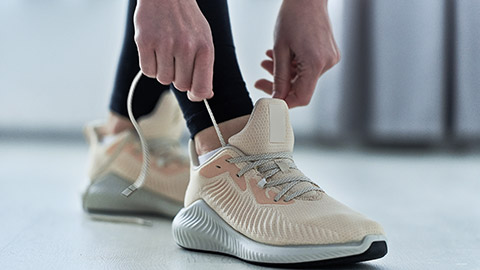
Respiratory protection
Washing, drying and brushing dogs release hair and dander particles into the air, which can cause skin and respiratory irritation, allergic relations and general discomfort. Many shampoos and other grooming products can be hazardous over long-term exposure.
Wearing a face mask can help reduce the risk of all these issues. A disposable or reusable mask will be appropriate in most instances. However, check the SDS of all chemicals you encounter to determine whether higher-grade respiratory protection is needed while handling certain products.
Skin protection

Gloves
Hair, dander and grooming products may also cause skin irritation. To minimise contact with these irritants, wear disposable gloves. Change your gloves between each dog that you work with. That way, you minimise the risk of spreading infectious diseases, such as ringworm, between different dogs.
Disposable gloves will also help protect you from catching an infectious disease from a dog and will protect small cuts and scratches from infection. Even thin nitrile gloves will help to protect your hands from accidental scratches from the dogs you are handling.
You should protect your hands with heavier-duty gloves when working with cleaning products and disinfectants, such as rubber gloves.
Protective clothing
Grooming aprons, smocks, scrub tops and sleeve covers can be worn over the top of your uniform to protect it from grooming products and dog hair, and to help keep it from getting wet. When de-shedding double-coated breeds, such as the Siberian Husky or German Shepherd, some groomers choose to wear a mosquito net over their head to prevent the dog hair from sticking to their own hair or face.
Some protective clothing is disposable, while others are washable. Make sure to change your protective clothing between dogs to help prevent the spread of infection and to maintain a professional appearance (NorthStarlight n.d.).
Hearing protection
Between dogs barking, clippers buzzing, the noise of dryers and blasters, phones ringing, and customer conversations, a grooming salon can be a noisy place.Christies Direct 2021
Safe Work Australia (n.d.) states that workers should not be exposed to volumes louder than 85 decibels on average over an eight-hour shift. Most vacuum cleaners function at around 85 decibels. Volumes over 140 decibels can cause instant hearing damage.
You should wear hearing defenders if there is any risk of exposure to prolonged medium or sudden, loud volumes. Choosing low-volume equipment will also help protect your hearing and potentially reduce the stress levels of the more anxious dogs (Christies Direct 2021).
Eye protection
Grooming products and medicated treatments can be very harmful if they splash into your eyes. Wearing protective glasses or a face shield will prevent foreign substances from entering your eyes. Eye protection will also prevent dander and hair from irritating your eyes and protect them from unexpected injury from tools or dog claws.
Restraint Equipment
Restraint equipment restricts the dog’s movement and can cause anxiety for the dog. However, some dogs may need some restraint during the bathing, drying and/or brushing stages. In these situations, always use the least restraint possible to keep you and the dog safe.
Some common restrain equipment used in grooming include:
- slip leads
- grooming loops
- belly support straps or slings
- muzzles.
Use a slip lead to secure the dog when you walk it from its enclosure to the bath. Slip leads are useful because they are a leash that slips easily over the head of the dog and does not need to attach to a collar, which you need to remove to bathe and brush the dog. You may not need a slip lead for small dogs that you can comfortably carry.
A grooming loop is a loose lead, similar to a slip lead, that loops over the dog’s head and attaches it to the bath or a grooming arm, as shown in the following image. It allows the dog to turn its head freely but prevents it from jumping out of the bath or off the grooming table. You could also use a short leash to attach the dog’s collar to the bath or grooming table. Make sure to adjust the loop and the grooming arm so that the dog is comfortable. The loop should only be tight enough to prevent the dog from slipping its head out. The strap attaching the loop to the grooming arm should be short enough to prevent the dog from falling off the table, but long enough for the dog to sit and stand comfortably. You can lengthen the strap to allow the dog to lie down, if necessary. Just remember to tighten it again when the dog stands up.
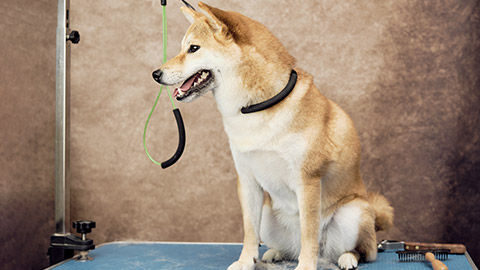
Belly supports and slings are straps that loop under the dog’s belly, close to its back legs. They prevent the dog from sitting down, allowing you to easily dry and brush their croup, tail and back legs. They can be used in addition to or instead of grooming loops to help restrain the dog and keep them safely on the table.
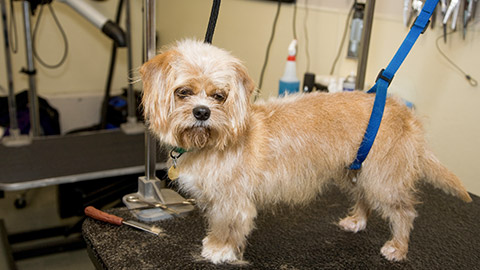
Muzzles wrap over the dog’s muzzle and prevent the dog from biting. The muzzle should be tight enough to prevent the dog from opening its mouth wide enough to grab at anything with its teeth, but not so tight that it puts pressure on the delicate blood vessels in the dog’s face or makes it difficult for the dog to breathe.
Muzzles should only be used on aggressive dogs. If possible, get the owner to fit the muzzle.
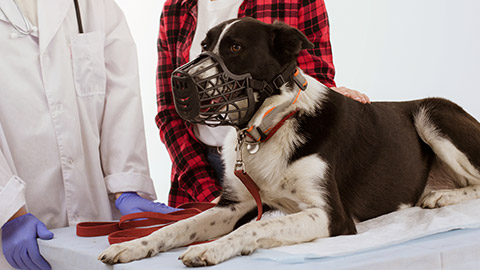
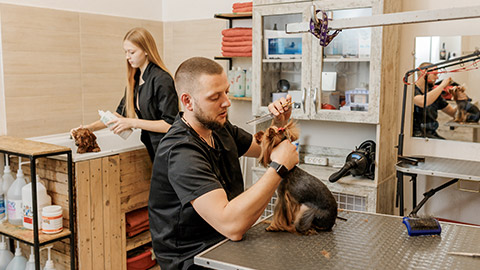
Once you have selected all the equipment needed for the work task, set up your work area safely, but have all the equipment in convenient, easy-to-reach locations. Essentially, you can’t leave the dog unattended once you start the process of bathing, drying and brushing, so everything you need must be at hand.
Convenient Access to Equipment and Products
The following list outlines the basic steps to set up your workstations for bathing, drying and brushing dogs.
- First, check all your equipment for cleanliness and damage. Dirty or damaged equipment may cause injury to you or the dog. Send unsuitable items for cleaning or repair, or dispose of broken equipment if it cannot be repaired.
- Prepare all bathing products and place them within easy reach.
- Place towels within easy reach of the bath, but where they won’t get splashed.
- Prepare all drying and brushing equipment and products and place them within easy reach of the grooming table.
- Position the grooming arm at the most convenient position for you to work around. Consider the type of table and whether you are left- or right-handed. When brushing dogs for showing, Leading Edge Dog Show Academy (2023) recommends positing the grooming arm on the dog's right-hand side, approximately 15-20 cm from the front edge of the table.
- Ensure you have a first aid kit within easy reach. It is important to be able to attend to the dog or yourself quickly in an emergency, such as bandaging a bleeding cut.
Ensure Pathways are Safe and Clear
Once your work areas, tools, equipment and products are set up, check that the path between the dog’s housing and the work area is safe and clear.
- Ensure all other animals are either secured in their housing or with a staff member.
- Remove any hazards that may cause you or the dog to slip or trip.
Measuring Quantities and Interpreting Numerical Information
You will need to measure various quantities and follow numerical instructions to properly select equipment and prepare products for an individual dog. The key measurements you will need to make include:
- Volume
- Weight
- Area
- Ratio
- Time
Measuring Volume
Volume is the amount of three-dimensional space something takes up. In grooming workplaces, volume is most commonly used to measure amounts of liquid, such as water, grooming products and cleaning products.
Safety note
Before accessing and measuring any chemicals, locate and read the relevant SDS. Check and follow any specified handling instructions and wear all the recommended PPE. If you finish any products, follow the SDS instructions for disposal of the container and any remaining product.
In Australia, the volume of a liquid is measured in millilitres (mL) or litres (L).
1000 mL = 1 L
1 cup = 250 mL
To measure volume, you will need a measuring cup or jug. Measuring cups and jugs come in a variety of sizes, depending on their purpose. Consider the product you are measuring and the amount you require, then choose the most suitable measuring cup. For example, if you need to measure 1.5 L of cleaning solution and you choose a measuring cup with a maximum capacity of 120 mL, it will take you much longer to measure the amount than if you choose a 2 L measuring jug. On the other hand, if you only require 10 mL of concentrated medicated shampoo, a 50 mL measuring cup will be a much easier and more accurate tool to measure the amount than the 1 L jug.
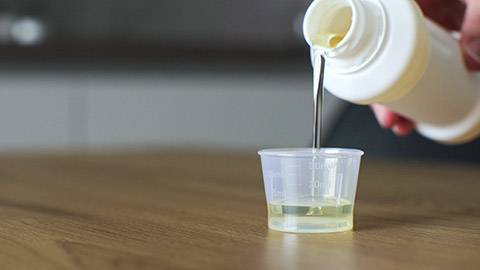
Many products can be purchased in large, bulk containers. In these instances, it is more space efficient and convenient to decant enough product to last the day into a smaller, more manageable container to keep at your workstation. Ensure the smaller container is clean and dry and clearly label it with the product it contains and the date you filled it with new product.
Measuring Ratio
Dilution is the process of mixing a concentrated product with water to achieve the correct strength of the product. Many grooming and disinfecting products require dilution. Dilution rates are typically expressed as a ratio, with the product listed as the first number and the water as the second. For example, a dilution ratio of 1:10 (one to ten) means you need to mix one part of the product with 10 parts of water. The dilution ratio will be listed on either the label of the concentrated product or in the manufacturer’s instructions. Some brands of products also sell dilution bottles in varying volumes, to best suit the product and your needs. For example, the Heiniger ProGroom Dilution Chart (pdf) provides examples of several different dilution ratios and specific volumes of water and product needed for five different sizes of container. Make sure you prepare your diluted products before you start working with the dog.
Safety note
As mentioned previously, it is always safest to wear gloves when handling or diluting chemicals. Even if the SDS does not list the product as harmful, gloves will help protect you from contact dermatitis, which can result from frequent handling of concentrated products.
Always use a clean and sterilised container for dilution. Bacteria commonly breed in the product residue in dirty containers. Reusing dirty containers will contaminate the new product and spread disease.
Follow the SDS instructions for the appropriate disposal of any remaining or spilled product.
There are two methods for diluting products. The first method is suitable for when you have flexibility around the final volume. You will need to use the second method when you need a very specific final volume.
Dilution method 1 - basic
Scenario: F10®SC Veterinary Disinfectant is a common hygiene product used when cleaning grooming salons. Depending on its use, the manufacturer recommends three different dilution ratios. You need to make up approximately 10 litres of diluted disinfectant for mopping the floors.
| Step Instructions | Example Calculation |
|---|---|
|
1:250 (one part of the product to 250 parts of water) |
|
A small measuring cup and a measuring jug will be suitable. |
|
A standard 10 L mop bucket has a larger capacity than 10 L, so it will be suitable to dilute the product directly into the bucket. |
|
Use the 1 L jug to measure and pour 10 L of water into the bucket. |
|
10 L ÷ 250 = 0.04 L = 40 mL |
|
Use the small measuring cup to measure 40 mL and add it to the buck of water. |
|
Dilution method 2 – exact volume
Scenario: You need to clean a bath suspected of giardia contamination. Giardia infections cause stomach cramping and diarrhoea in both people and dogs. For this level of disinfecting, a 1:100 dilution ratio is recommended for F10®SC Veterinary Disinfectant. You need to make up exactly 500 mL of diluted disinfectant for wiping down the bath.
| Step Instructions | Example Calculation |
|---|---|
|
1+100 = 101 |
|
500 mL |
|
500 ÷ 101 = 4.95 mL |
|
500 – 4.95 = 495.05 mL |
|
4.95 + 495.05 = 500 mL |
Activity 1: Measuring ratios for dilution
You need to make up a 1 L application bottle of Heiniger ProGroom Easy Rinse Conditioner. Follow the hyperlink to go to the product website and locate the dilution ratio for a “light conditioning”. Then calculate the amount of product and water you will need to add to the 1 L application bottle, using the basic dilution method.The dilution ratio is 1:40.
1 L = 1000 mL
1000 ÷ 40 = 25 mL of product
1000 mL of water
Measuring Weight
Weight is how heavy an object is. In Australia, weight is measured in grams (g) or kilograms (kg).
1 kg = 1000 g
Anytime you need to lift something, be it a dog, a box of products or any equipment, you should know how much it weighs. To avoid manual handling injuries, do not lift anything by yourself that is too heavy. Seek assistance or use equipment to lift and move heavy or awkward items.
In grooming, you may need to weigh the dogs on a set of scales. Ensure the scales are on the floor and encourage the dog to walk on to them independently.
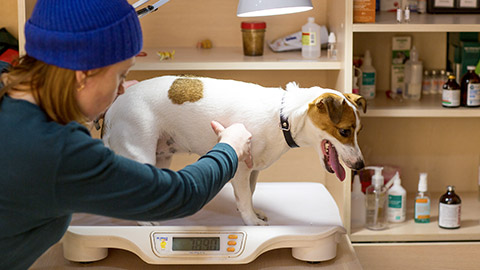
Knowing the dog’s weight is important because many baths and grooming tables have a weight limit. Exceeding the weight limit of a piece of equipment puts both the dog and you at risk of injury if the equipment breaks underneath the dog.
Check the manufacturer’s instructions for weight capacities and choose the most appropriate equipment for the individual dog. For example, the Aeolus FT-808/808Pro Low-Low Electric Lifting Table has a weight capacity of 150 kg.
Measuring Area
Area is the amount of two-dimensional space. It is calculated by multiplying the length by the width of the space.
Area is typically measured in square metres or metres squared (m2).
To convert from cm2 to m2, divide by 10 000.
Area is important in the animal care industry in terms of housing, exercising and transporting animals. The Freedom to express normal patterns of behaviour states that an animal should have the space to move freely, including the ability to sit, stand and lie down in natural positions. An animal that is housed, exercised or transported in an inadequate area will not be able to express normal behaviours and movements.
In grooming, the area of the holding cage must allow the dog to move around freely, sit, stand and lie down comfortably. While the dog’s movement is restricted by grooming loops, the area of the bath and grooming table must also be adequate for the dog to sit, stand and lie down comfortably.
Activity 2: Measuring the area of a dog holding cage
NSW Agriculture (1999) provides the following information, indicating the minimum dimensions of enclosures for dogs of different sizes, assuming only one dog per cage.
| Weight of dog | Minimum floor area (m2) |
|---|---|
| <12 kg | 1.00 |
| 12-30 kg | 1.20 |
| > 30 kg | 2.23 |
A client brings a Border Collie to the salon to be washed, dried and brushed. There are two cages available in the holding area:
- Cage 1 measures 120 cm × 90 cm
- Cage 2 measures 120 cm × 120 cm
Step 1: Use the Dogs Australia breed standards to determine the average height of this breed.
Step 2: Calculate the area of each of the cages.
Step 3: Use the previous table to determine the most suitable cage for the Border Collie.
Cage 1 has an area of 120 × 90 = 10 800 cm2 = 1.08 m2
Cage 2 has an area of 120 × 120 = 14 400 cm2 = 1.44 m2
Cage 1 is too small for a Border Collie, but Cage 2 meets minimum requirements.
Measuring Time
Bathing, drying and brushing different dog breeds may take different amounts of time to complete. Knowing how long it will take you to complete a particular task is important for planning your day. Grooming salons make client bookings based on their groomers’ schedules and availabilities. Poor understanding of time or poor time management will result in inconvenienced clients and a stressful day for you.
In grooming, depending on the task, time is measured in minutes and hours. For example, it may only take you 10-15 minutes to blow dry a short-coated dog, but 2 hours to complete a full wash, dry and brush of a drop-coated breed.
You can measure time with a stopwatch or by simply looking at the clock when you start and finish a task and calculate the time it took. You will likely find that you will get quicker at some tasks as your experience grows.
Some products may need to be left in the coat for a set period before being rinsed out. You can use a stopwatch, clock or timer to measure the time. Many timers have an alarm to notify you when the time period has finished. Most smartphones have a clock, stopwatch and timer app as standard.
Make sure you check and follow the manufacturer’s instructions regarding how long a product should be left in a coat. Some products may cause irritation or serious skin conditions if left in too long.
Activity 3: Measuring time
Pyohex® Medicated Shampoo is used to treat Staphylococcus pseudintermedius, a bacteria that infects dog skin.
Locate the directions for the use of this product, then answer the following questions.
Question 1: Identify how long the product should be left in the coat before rinsing.
Question 2: If you applied the medicated shampoo at 3:53 pm, what time should you start rinsing it out?
- Q1 answer: 10 minutes
- Q2 answer: 4:03 pm
Complete the following six (6) activities to check your knowledge and understanding of the key concepts of this topic. You may repeat this activity as often as you like. Use the arrows to move between the different activities.
